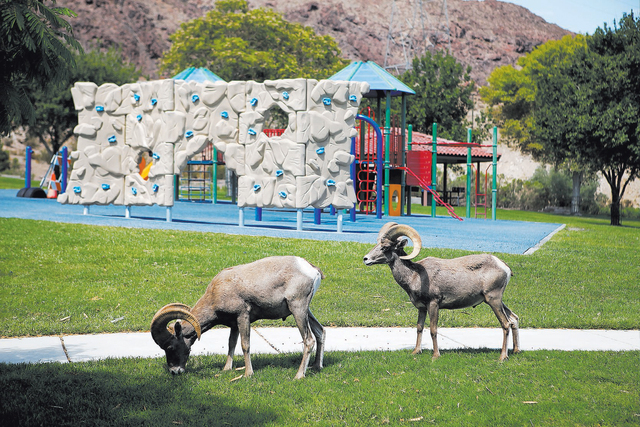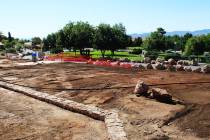Pneumonia outbreak now called ‘worst-case scenario’ for bighorn sheep
In what wildlife biologists are calling “a worst-case scenario,” bighorn sheep in four Southern Nevada mountain ranges have tested positive for bacteria that causes deadly pneumonia, including one herd infected with two different strains.
Nevada Department of Wildlife officials announced last week that a bacterial pneumonia outbreak first discovered in the River Mountains between Henderson and Boulder City in August appears to have spread to sheep in the Eldorado, McCullough and Spring mountains.
The herd in the Spring Mountains also has tested positive for a second strain of bacteria that may have spread north from an outbreak that swept through Mojave National Preserve in California.
Bighorn have no natural resistance to pneumonia and tend to die at a high rate. Those that survive become carriers, infecting and eventually killing newborn lambs in a cycle that can diminish a herd for as long as a decade, if not kill it off altogether.
The widening outbreak also seriously complicates efforts to restore bighorn to its historic ranges throughout Nevada and the West, since many of the animals being relocated come from Southern Nevada.
“This is a worst-case scenario,” wildlife biologist Pat Cummings said in a written statement. “Given the geography between the Spring Mountains and the outbreak area in California, we were concerned this might be possible, especially with the ability of bighorn rams to cover vast amounts of territory in their wanderings. There is no way to limit these animals’ movements.”
There also is no way to treat sick animals or vaccinate healthy ones against the illness, which does not pose a risk to humans.
“We’re almost at the mercy of Mother Nature,” said department of wildlife spokesman Doug Nielsen.
When the outbreak in California was discovered last spring, wildlife managers briefly considered — then decided against — the wholesale slaughter of bighorn sheep to stop the disease from spreading across the entire 1.6 million acre preserve and beyond.
Since then, more diseased bighorns were found in the preserve’s Marble range.
Wildlife officials don’t know for sure how many sheep have died of pneumonia or how many more will die, but population numbers appear to be down in the affected areas on both sides of the border, said Peregrine Wolff, the state wildlife veterinarian for Nevada.
The bacteria that causes pneumonia can linger in bighorn sheep herds and continue to kill off lambs “for years and years and years,” Wolff said. “Our concern is will these numbers ever recover or will they just continue to be depressed?”
Wildlife officials also worry the outbreak could jump to other herds, including one in the Muddy Mountains near Moapa Valley that ranks as the largest herd in Southern Nevada.
Wolff said “nothing really” can be done to stop it. Trying to kill sick animals or eliminate an infected herd to halt the spread of bacteria is “far from an exact science,” she said.
“We’re not going to go in and lay down every sheep. We’re not going to nuke them.”
Instead, wildlife officials are asking the public’s help to chart the course of the outbreak. Anyone who spots sick or dead bighorn sheep is asked to record it, preferably with a picture and GPS coordinates.
Reports can be made by calling the department of wildlife’s Las Vegas office at 702-486-5127 or sending an email to pcummings@ndow.org.
Wolff suspects the outbreak in Southern Nevada has been underway since 2012.
The latest discovery of infected animals came about through testing conducted by the Southern Nevada Bighorn Sheep Disease Investigation Project, a partnership involving the Department of Wildlife and two conservation and hunting organizations: the Fraternity of the Desert Bighorn and the Wild Sheep Foundation.
In November, the partnership collected samples from 33 bighorn, 10 each in the Eldorado and McCullough ranges and 13 in the Spring Mountains. In all but two cases, the sheep were tested and released unharmed.
Since September, wildlife officials have caught, killed and dissected one sick lamb from the Eldorado Mountains and one sick lamb from the River Mountains, both of which showed signs of pneumonia.
Bighorn sheep once roamed nearly every mountain range in Nevada, but unregulated hunting, habitat loss and disease spread by domestic livestock reduced the population to about 1,200 animals in a handful of areas, none of them north of Ely or west of Hawthorne.
Since 1967, wildlife officials have restored Nevada’s official animal to more than 60 mountain ranges and helped boost their total population to more than 11,000 adults, more than any other state. The River Mountains herd played a key role in the recovery, supplying more than a quarter of the nearly 2,900 sheep captured and relocated during the past 45 years. “That was our jewel,” Nielsen said.
Not anymore. Officials have put a stop to the relocation of bighorns from any herd showing signs of the bacteria. Wolff said the infected herds could be off limits for years, if not forever.
Contact reporter Henry Brean at hbrean@reviewjournal.com or 702-383-0350. Follow him on Twitter at @RefriedBrean.
















